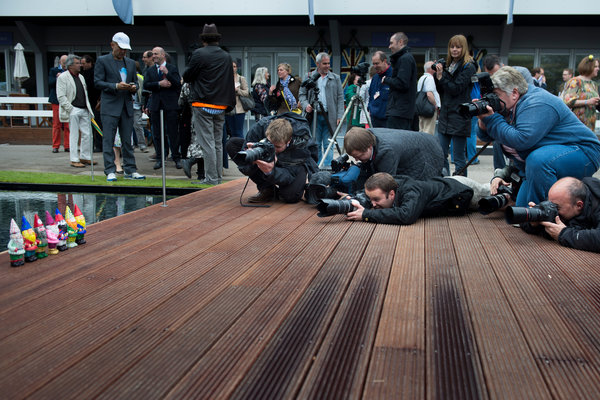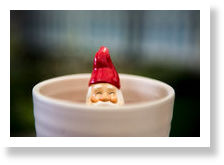
So it was not surprising that the staid Royal Horticultural Society's decision to allow garden gnomes - creatures commonly associated with the landscapes of the unrich, the unfamous and the untasteful - at the Chelsea Flower Show this year elicited a variety of responses.
Such as people all but fleeing in horror when the word was mentioned. "Gnomes?" said one exhibitor on Monday, when the show opened in preview. "I can't comment on gnomes."
Some exhibitors went proud and loud, putting gnomes in places they would not be missed, like in the middle of the grass. Others seemed to feel that gnomes may be fine for other people, but certainly not any people they know, or want to know. One renowned landscape architect, Robert Myers, hid a gnome in a tree in his display, lost his nerve and took it out again before the judges could see it.
"I don't know where he went," Mr. Myers said of his erstwhile gnome.
And then there were the Hewitt brothers, Paul and Richard, who were exhibiting greenhouses and who showed up dressed in gnome outfits that they had purchased on eBay and accessorized with beards they had fashioned themselves.
They had misunderstood, and were feeling a little sheepish. "We thought there'd be loads of people dressed as gnomes," said Paul Hewitt, 50.
Richard Hewitt, 57, said it reminded him of the time he went to a black-tie party dressed as Ozzy Osbourne, having mistakenly thought he was going to a costume party.
The flower show is the horticultural society's most important and influential occasion in this gardening-mad country, drawing Britain's top gardeners and thousands of horticulture enthusiasts. Exhibitors spend several weeks and, sometimes, hundreds of thousands of dollars creating entire gardens that compete for various titles and are seen by the country's keenest and most discerning gardeners.
Gnomes, which are called "brightly colored mythical creatures" in the handbook governing the show, are not really part of the Chelsea aesthetic. (Nor are balloons, flags, "feather flags," or "any item which, in the opinion of the society, detracts from the presentation of the plants or products on display," the handbook reads.)
But outside the rarefied world of the flower show, garden gnomes - small and cheery, or small and creepy, depending on your perspective, and typically dressed like the dwarves in "Snow White and the Seven Dwarfs" - are extraordinarily popular.
Tackiness, it seems, is in the eye of the beholder.
"There are a lot of people who are gnome fanatics, who will literally buy any gnome going," said Sally Chambers, décor brand manager at Solus, a company offering gardening-related products that has sold 200,000 gnomes in its Woodland Wilf line since 2009.
Customers have multiple Wilfs to choose from, including Wilf lying on a leaf, Wilf watering the plants, Wilf sheltering under a mushroom and Wilf playing golf.
"They put it in the front garden, the back garden," Ms. Chambers continued. "They send me photographs of their gnome collections. There's a lady who's quite a good photographer, who uses Wilf as a subject and sells the photos on the Internet."
Jonathan Jones, the garden director at the 14th-century Tregothnan estate in Cornwall, said he was not embarrassed at the inclusion of a gnome in his Chelsea exhibit. The gnome, cunningly sitting inside a kind of mini-indoor greenhouse called a Wardian case, can usually be found on the estate, by the clock tower.
The owners of large estates in Cornwall have a humorous habit of playing gnome-related tricks among themselves, Mr. Jones said, sometimes unexpectedly placing gnomes in odd places on one another's property. "Once someone decapitated one of our gnomes," he said.
As part of its new gnome-friendly policy, the horticultural society gave a group of gnomes to a group of celebrities, who then decorated them (Elton John gave his huge sunglasses with pink rhinestones). The gnomes, which are on display at the flower show, are to be auctioned off to raise money to help educate children about gardening.
And about time, said Laurence Llewelyn-Bowen, a celebrity who gives decorating advice on television and who painted his gnome in a classic English landscape.
"Gnomes are very symbolic in English gardens, as an anti-class statement," said Mr. Llewelyn-Bowen, who happened to be passing by his painted gnome as he prepared to tour the garden show. He said he had a colony of gnomes in his garden.
"It's good to confront the received wisdom that all gnomes are nasty," Mr. Llewelyn-Bowen said. Referring to his wife, he added: "Also, Jackie has had to overcome her poshness and confront her gnomophobia."
"I've learned that there's no place for gnomism in my life," Ms. Llewelyn-Bowen said.
The loosening of the gnome restrictions applies only to this year, the centenary year of the Chelsea Flower Show. Next year the ban will return.
Not everyone will be sorry. A new advertising campaign for Ikea shows gangs of evil gnomes menacing a couple in the couple's garden, whereupon the couple attacks back, drowning the gnomes, hurling them against a fence and smashing them to bits.
At the stand for Kings Seeds, a gnome in a little green hat sat in what on closer inspection turned out to be a chamber pot.
"It's a joke, really, to show what we think of gnomes," said Les Day, the managing director. "From a practical point of view, if you're growing seeds in your garden you don't need them, really. It's more practical to put in something like netting or slug repellent."




Must every New York Times article be a thousand words long and soporific?